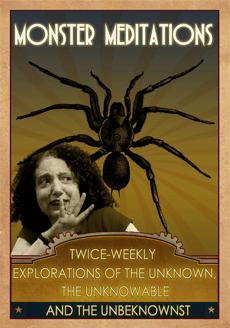The psychotherapist Carl Jung wrote about the role that archetypes play in our collective unconscious. The Trickster, Hero, Maiden Wise Old Man, Magician, Witch, Faithful Dog, etc. are familiar types — as is the Shadow (the representation of the dark side of an individual). These archetypes are everywhere in fiction —from classic fairy tales and sitcoms to Disney movies and noir detective novels.
Classic Disney films drew archetypal characters in ALL CAPS — there was never a question about the motivations of Cruella de Vil (“101 Dalmatians”) or any subtly in the Disney versions of familiar fairy tales. I’d better state right here that I was never a Disney kid. Aside from a few of the movies —“101 Dalmatians” & “Fantasia” — come to mind, I usually found the movies simplistic or frustrating, as I didn’t like the Disney brand of humor.
This is not to say that I don’t respect Disney’s accomplishments and innovations as a movie studio and entertainment company. I was very impressed with “Destino” — the Disney/Salvador Dali collaboration produced in 1945 and not released until 2003. I just think that the Disney incarnation of familiar archetypal characters are very hard to shake. They’ve become entrenched in our imaginations. The pure, sweet, beautiful princess IS our incarnation of Jung’s Maiden. Magical women — witches and sorceresses — are always dangerous, while magical men — magicians and wizards — are more likely to be mysterious and powerful.
It’s Jung all the way! (Through a Disney lens.)
That’s why I was so happy to see “Maleficent.” I caught it on a plane and it did more than pass some time in the air — it upended the Disney/Jungian archetypes with all the production values of a Disney creation. Even if you’ve had your fill of Disney fairy tales, find your way to this one and see if it doesn’t shake up a few of those all-too-perfect archetypes.





blah…
I like the arch types. I am a fan of the whole super hero vision. Good guys are good guys and villains are villains. I have heard enough about this “movie” to know it is one that would probably just annoy me more than anything else.
Maybe I was raised with too many old spaghetti westerns. The good guys always wear a white hat and the bad guys always wear a black hat. Sure there may be lines to cross every now and then but the roles are essentially the same.
(Granted I do like to watch the villains win but this is a villain doing villainy not a misguided or misunderstood hero in her own story)
LOL! You are such a boy!
The archetypes are so much more interesting/inspiring for male characters. The beauty = good, ugly = bad equation for women and girls weighs on girls as they grow up, waiting for a prince/hero. The wait in reality is… well, let’s just say that the prince is always described as “charming” and not loyal, clever, loving… Two Broadway myth busters — Wicked and Into the Woods — do this very well.
Glad to hear from the other side of the archetypal divide!
I was ready not to like Malificent (and caught it on a plane) because I thought they would pull some relativism b.s. But they really turned the story on its head, and I ended up loving it.
That was EXACTLY my experience. I didn’t run out to see it in the theater, even when reliable friends said it was good, because I was prepped to dislike it. There it was on the plane and I was transported — in more ways than transatlantic.
It got me thinking about the simplistic Disney versions of Jungian archetypes and how captive we become when we grow up with very specific concepts of what GOOD and EVIL look like and how limited the roles are for women in this canon of archetypes. It’s definitely time to have fun with the stereotypes and delve deeper.
Oh thanks for this! I don’t actually mind the old Disney archetypes – as animations – but tend to steer clear of them when they involve real people. Now, however, I may just watch Maleficent to see what you mean. 😀
Yes, give it a try. The special effects are magical and the message upends the typical Disney characters, motivations and messages.
I haven’t seen Maleficient yet, but it’s on my Netflix queue. I’ve never been too enamored of clearly drawn archetypes, but grew to appreciate them more when I had to teach Arthurian Legend and the Odyssey. I ended up making a whole hero unit with the culminating activity being a presentation on a superhero of choice. The boys loved it, and the girls thought it was decent as well. I like the gray-area characters like Cat Woman.
I love Arthur and the Odyssey but I guess I want the archetypes in today’s fiction to resonate with more complex female characters. I think both the male & female characters should, or could, exist in the gray areas like Cat Woman. Girls are more than sugar and spice OR menace. Right? At least I think we are.